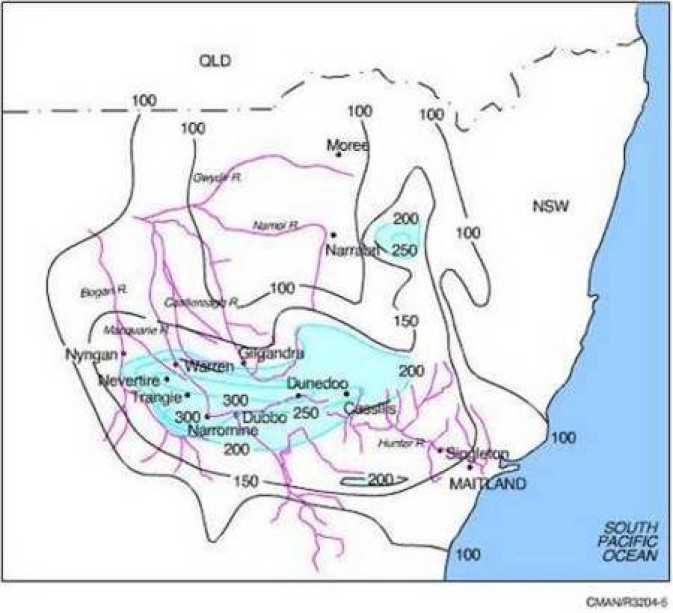Hunter Valley Flood Map.
Rainfall isohyets (in mm) for the “Maitland flood” event of February 1955.
Floods Occurred over a large area of central New South Wales, devastating many Kytherian families and businesses.
What was your experience of the 1955 floods?
Hunter Valley, February 1955
The Hunter Valley floods of late February 1955 have, in many people’s minds, come to symbolise flooding in Australia, helped by the dramatic images from the movie Newsfront.
Heavy rain had fallen over much of eastern Australia from October 1954 when, on 23 February 1955, an intensifying monsoon depression moved south from Queensland. Torrential rain developed, particularly over the area of New South Wales from Warren to Cassilis. Rainfall totals exceeded 250mm in 24 hours between Nevertire and Dunedoo, a phenomenal amount for this area. Heavy rains then moved east across the Liverpool Ranges and down the Hunter Valley. With such intense rain falling on already saturated ground the Hunter, along with several westward-flowing rivers, soon reached unprecedented levels.
At Maitland, on the banks of the Hunter, the river surged nearly a metre higher than the previous record this century, set three years earlier. More than 5,000 homes were flooded - in some cases submerged - by anything up to five metres of muddy water. About 15,000 people were evacuated, many plucked from rooftops by boat or helicopter. The floodwaters destroyed 31 homes in Maitland, but more than 100 more were so badly damaged that they had to be demolished. Fourteen lives were lost, including five due to electrocution during rescue operations. At Singleton another 1600 homes were flooded.
West of the Divide, the Macquarie River exceeded its previous record height by 1.6 metres at Dubbo, where five houses were destroyed and 4000 residents evacuated. More than a metre of turgid, muddy water covered the main street. It was a similar story at Narromine, Warren, Trangie and other towns in the Macquarie Valley. The Castlereagh also reached a record height, with waist-deep water swirling through the shopping centre at Gilgandra, wrecking a third of the buildings. A hole torn in the main street was later found to contain two large semi-trailers. Twenty-four homes were totally destroyed and 350 were badly damaged.
The Namoi and Gwydir valleys were devastated. Narrabri was completely isolated; water up to three metres deep covered some streets. About 1000 homes at Narrabri, and nearly as many at Moree, suffered water damage.
As a whole, the flooding took the lives of 25 people. Some 2,000 cattle and many thousands of head of other livestock were drowned. The damage to bridges, roads, railways and telephone lines took months to repair.
The Hunter Valley event was but one - albeit the most spectacular - of many heavy rain episodes over eastern Australia between late 1954 and the end of 1956, a period dominated by La Niña conditions. The year 1956 was remarkable in that repeated flooding occurred throughout the vast Murray-Darling river system throughout the first half of the year.
Australian Government.
Department of Meteorology
http://www.bom.gov.au/lam/climate/levelthree/c20thc/flood5.htm
